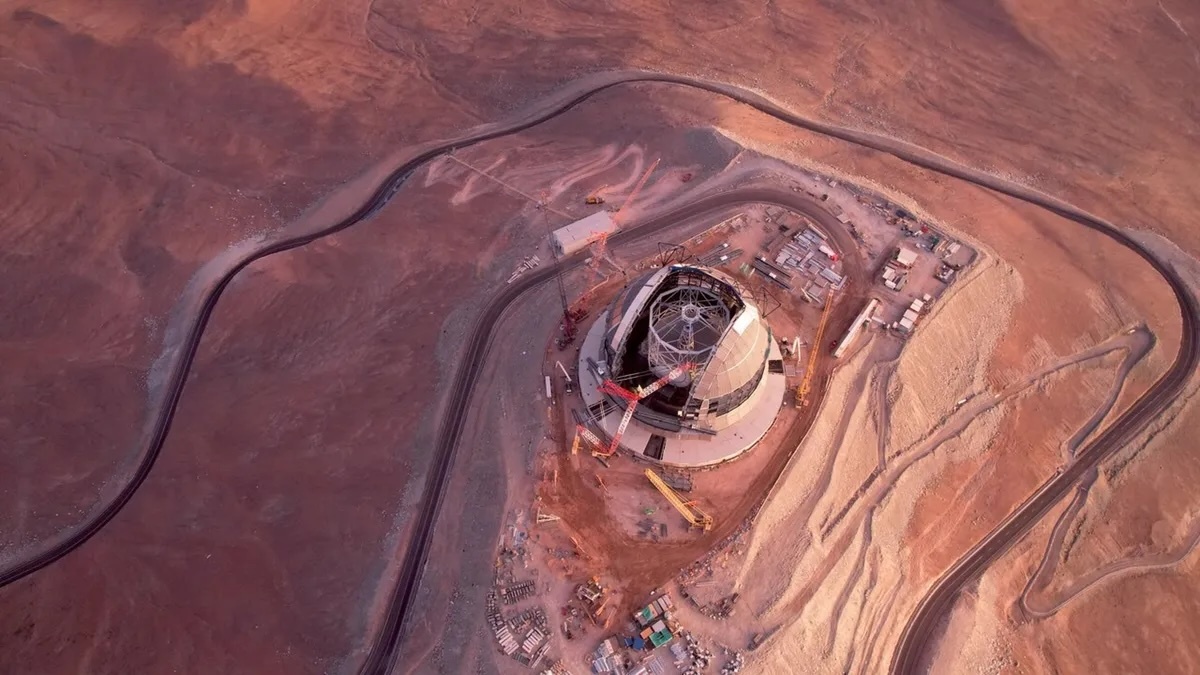21.12.2017
When complete, the ELT dome will stand almost 262 feet (80 meters) high atop Cerro Armazones, a 1.8-mile-high (3 kilometers) mountain in the Sierra Vicuña Mackenna section of the Chilean Coast Range in the Atacama Desert, where the instrument will face rigorous winds. [The Biggest Telescopes on Earth: How They Measure Up]
"These conditions present an engineering challenge, making wind-tunnel tests vital," ESO officials explained in a new video.

Credit: ESO
-
During the tests, a model of the ELT faced blustery conditions in a wind tunnel at the Polytechnic University of Milan in Italy. It was plastered with sensors to measure the structural load it could face.
"The wind-tunnel test is developed to reproduce the conditions that the ELT will face when it's operational," said engineer Luca Ronchi in a blog post, "so, basically, it's about reproducing the dome and telescope on a smaller scale (made of glass-fiber-reinforced plastic), equipping it with sensors, calibrating these sensors, placing the object in the wind tunnel and — according to the established and agreed-upon test program — reproducing the conditions that the ELT will actually face on top of Cerro Armazones."
When complete, the Extremely Large Telescope will use a colossal, 128-foot (39 m) primary mirror, made up of 798 hexagonal mirror segments, to survey the universe like never before.
Quelle: SC
----
Update: 21.12.2023
.

Primary mirror, M1, segments of ESO’s Extremely Large Telescope (ELT) awaiting finishing at Safran Reosc facilities in France. 798 hexagonal segments will work together on the ELT, acting as one giant mirror 39-metres across. Credit: Safran, handout
The first 18 segments of the world’s largest telescope are en route to Chile in preparation for what will be one of astronomy’s biggest constructions on record.
Once complete, the European Southern Observatory’s Extremely Large Telescope (yes, that’s what it’s called) will be the biggest optical and near-infrared ground-based telescope. The project has been in development for nearly 20 years, with construction approved a decade ago.
It is due to come online in 2028.
The assembly of the telescope’s massive mirrors will take place over the next 4 years. This week, the first segments of what will be the main mirror – called ‘M1’ – arrived in Chile.
In total, M1 will consist of 798 mirrors assembled into an almost 40-metre-wide lens.
Before their arrival, these smaller mirrors had their imperfections atomically polished out by French optical systems manufacturer Safran Reosc by ‘sweeping’ their surface with a beam of ions that eat away at the irregularities. Any remnant flaws are no more than 10 nanometres wide – about the size of a biological cell membrane.
The remaining 780 pieces of M1 will be polished and shipped in the coming months, around 4 segments are being prepared each week by Safran Reosc.
The Extremely Large Telescope will be built in the Atacama Desert in the north of Chile, which is one of the darkest skies in the world.
Quelle: COSMOS
----
Update: 20.01.2025
.
The mighty telescope is expected to see its "first light" by 2028.

ESO's Extremely Large Telescope under construction in the Atacama desert in January 2025. (Image credit: ESO/G. Vecchia)
The frame of the dome that will house the world's largest telescope has been completed, marking another key milestone in the observatory's construction.
The European Southern Observatory's (ESO) Extremely Large Telescope (ELT) — the world's largest visible- and infrared-light telescope — is currently under development on the Cerro Armazones mountain in Chile's Atacama Desert. The mighty telescope is expected to see its "first light" by 2028.
New photos from the ESO show that the dome's frame is now completed, while the outer shell that will fully enclose the telescope is still under construction. Plates of aluminum will be added to the exterior of the frame to protect the telescope from the extreme environment of the Atacama desert, including variable temperatures, according to a statement from the observatory.
The dome measures 305 feet (93 meters) in diameter, or about the size of a football field and stands 263 feet (80 meters) tall. The dome will house the ELT, which aims to observe terrestrial exoplanets and their atmospheres, as well as measuring the expansion of the universe.

ESO's Extremely Large Telescope under construction in the Atacama desert in January 2025. (Image credit: ESO/G. Vecchia
The latest progress photos taken in January 2025 show cranes busy at work installing the outer aluminum layers, also known as cladding. Part of the dome will have large sliding doors, which will remain closed during the day and open at night, allowing the telescope to survey the sky.
Progress has also been made on the polygon structure at the base inside of the dome that will support the telescope's main mirror (M1), and on the "spider" structure on top of it, which will hold the secondary mirror (M2) in the center. M1 will measure a whopping 128 feet (39 meters) across, while M2, which is expected to be completed later this year, will measure 14 feet (4.25 meters) in diameter. The telescope will have three smaller mirrors, for a total of five once complete.
ESO also shared an up-close view of the inner frame of the "spider" structure, named for its arching shape poised above the base, with six arms reaching out from its center. While the skeleton itself is complete, it is waiting to receive all of the individual segments that will make up the five mirrors. M1 alone will consist of 798 glass ceramic hexagonal segments, each of which measure about 2 inches (5 centimeters) thick and about 5 feet (1.5 meters) across. When fully assembled, M1 will be the largest mirror ever built for an optical telescope.
The central tower below the "spider" structure will support the ELT's remaining three mirrors. These components — the central tower, spider structure and polygon base — are all hosted on what is called the altitude structure. This metal frame stands 164 feet (50 meters) tall and is designed to carry all 5 mirrors of the ELT and rotate so that the telescope can be pointed at different parts of the sky.
Quelle: SC